
Centre of Jaina Studies Newsletter: SOAS - University of London
Founded in 1683, the Ashmolean is fortunate in having the most representative collection of Indian art in Britain outside London. The Museum's first major Indian sculpture, an 11th- century Pala stone image of Vishnu, was acquired as long ago as 1686. A flurry of Indian collecting activity began in Oxford in the late 19th century, with the founding by Sir Monier MonierWilliams (1819-1899), Boden Professor of Sanskrit, of the University's former Indian Institute (1897-1962). Artefacts of all kinds were gathered throughout India for the Institute's new museum, and further sculptures and other works of art were subsequently donated by noble or wealthy Indian benefactors and British military men or civil officials who had served in the subcontinent. The majority of these gifts were images of Hindu deities or else Gandhara Buddhist works from the Northwest Frontier region. Jain works were very much in a minority. However, among numerous gifts presented in the name of the Maharaja of Jaipur in the 1880s was a bevy of contemporary local soapstone sculptures depicting seated Jinas. Of greater artistic merit, though in a worn condition, was a 12th-century stone stele with a standing Jina image from Bankura District, Bengal, given by the great musicologist Sir Sourendro Mohun Tagore (18401914). Later, in the aftermath of empire, the Indian Institute was abolished by the University in 1962 and its collections were transferred to the Ashmolean's newly formed Department of Eastern Art. A 3rd-4th-century Mathura sandstone Jina head was presented at that time by the widow of Prof. William Cohn (1880-1961), who had done much to lay the foundations for the new Department.
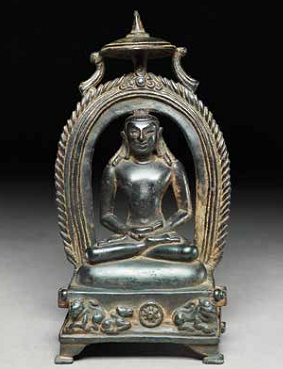
Bronze seated Rishabhanatha
Bihar, 7th century
EA1998.15
Image © Ashmolean Museum, University of Oxford
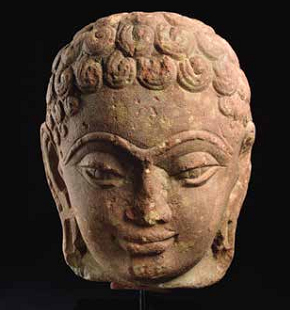
Sandstone head of a Jina
Mathura, 3rd-4th century
EA1963.27, Gift of Mrs Isabelle Cohn
Image © Ashmolean Museum, University of Oxford
Some further consolidation of the Jain sculpture collection also took place during the 20th century and more recently. Several dated brass Jina images from Rajasthan or Gujarat (15th-17th centuries) came from the collections of Col. C.E. Luard, who served in Central India in the early 1900s, and Dr James C. Harle (19202004), former Keeper of Eastern Art at the Ashmolean. They include a simple but unusual miniature portable shrine, dated 1633 (VS 1690), in which the hinged, temple sikhara-like cover opens to reveal a seated Parsvanatha image within. Metal sculpture acquisitions of earlier date have included a 7th-century bronze image of Rishabhanatha from Bihar and three fine 10thcentury bronze Jina images, from Orissa and the Deccan, previously owned by Douglas Barrett (1917-92), former Keeper of Oriental Antiquities at the British Museum. A few more stone sculptures were also acquired, including an 11th-century sandstone standing Jina image from Madhya Pradesh, and a section of a 12th-century marble torana arch, probably from Mount Abu, which had come to light in a private house near Bath. Of interest also is an inscribed marble shrine, dated 1725 (VS 1782), carved with the footprints of the teachers Jinadatta Suri and Jinakushala Suri.[1]
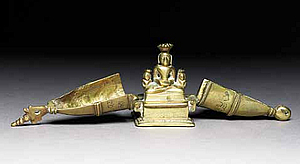
Brass portable shrine with seated
Parsvanatha and two other Jinas
Western India, 1633
EAOS.109
Image © Ashmolean Museum,
University of Oxford
Until recently Jain painting was hardly represented at all in the collection. But in 2012 the paintings collection of Simon Digby (1932-2010), an eminent historian of Sultanate and Mughal India and a former Ashmolean curator, came to the Museum through the trustees of his estate. Digby was a scholar-collector of extremely wide-ranging interests, and his collection included well over 200 Jain illustrated manuscript pages, book covers or other painted works, dating from the 14th to 19th centuries and sometimes unusual or unconventional in style. They include many illustrations from Kalpa Sutra and Sangrahani Sutra series, for example, as well as from other less frequently illustrated texts. The Digby collection also contained a substantial group of unillustrated Jain manuscripts, now in process of transfer to the University's Bodleian Library.
Andrew Topsfield is Keeper of Eastern Art, Ashmolean Museum, University of Oxford.
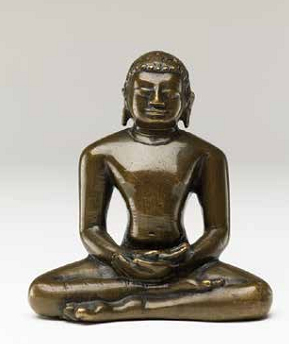
Bronze seated Jina
Southern Deccan, 10th century
EA2013.84, Bequest of Douglas and Mary Barrett
Image © Ashmolean Museum, University of Oxford
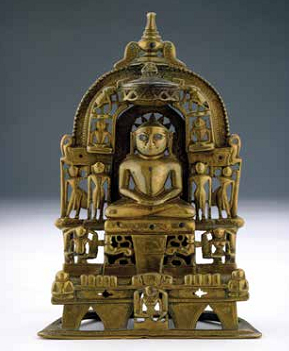
Seated Kuntunatha, brass with silver and copper inlay
Vasantagarh, Rajasthan
1476. EAOS.108, Gift of Mrs C.E. Luard
Image © Ashmolean Museum, University of Oxford
 Andrew Topsfiel
Andrew Topsfiel